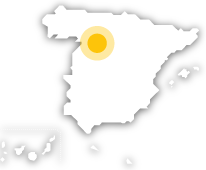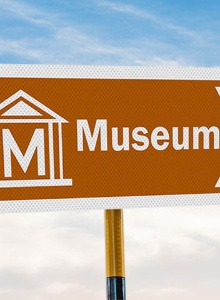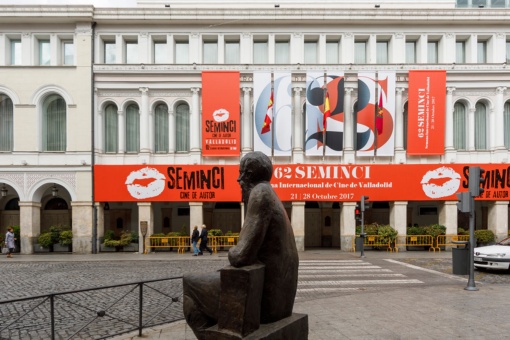The historic centre of Valladolid, the city on the Pisuerga River, is home to an interesting collection of Renaissance architecture comprising houses, palaces and emblematic buildings such as the Cathedral, the College of San Gregorio (today the site of the National Sculpture Museum) and the church of San Pablo.
The city has an intense cultural schedule thanks to its status as a university town, and hosts events such as the Seminci, the International Film Festival and one of the highlights of the Spanish film calendar, and the International Street Theatre and Arts Festival.
Another event that marks the life of Valladolid and arouses the fervour of its inhabitants is Easter Week. Declared a Festivity of International Tourist Interest its processions offer a genuine display of religious artworks passing before your eyes.Valladolid began to gain importance in the 11th century when Count Ansúrez became the governor of the town in the name of Alfonso VI. It reached its apotheosis during the reign of Ferdinand and Isabella (15th century), at a time when Valladolid University was one of the most important in the country. But in addition to playing a role in some of the key episodes in Spanish history, Valladolid has on two occasions been its capital; the first under Charles I (16th century) and subsequently when Philip III came to the throne in the 17th century.The historic centre of Valladolid conserves an important monumental and architectural heritage, particularly comprising noble houses and religious buildings. A highlight among these is the unfinished cathedral. The original design for the project was commissioned by King Philip II from the architect Juan de Herrera in the 16th century. The death of both men meant the cathedral remained unfinished, and its central section was not opened until 1668. Years later in 1730, the Master Churriguera completed the work on the main facade. Inside the cathedral, the main chapel houses a magnificent altarpiece produced by Juan de Juni in 1562. The space also includes the Diocesan Museum, containing a number of carved images attributed to Gregorio Fernández and to Juni himself, in addition to a silver monstrance by Juan de Arfe.Other religious buildings of interest are the Gothic church of Santiago, with an interesting altarpiece depicting the Adoration of the Magi made by Berruguete in 1537; and the church of Santa María la Antigua, with its unusual Romanesque tower crowned with a pyramid.Presided by a statue of Ansúrez, the 16th-century Plaza Mayor square is in the very heart of the city. On one of its sides stands the town hall, dating from the start of the century and crowned by the clock tower. The surrounding streets are home to a large number of stately houses and palaces. Pimentel Palace, today the site of the Regional Government, is one of the most important, as it was here on 21 May 1527 that King Philip II was born. Other highlights include the 16th-century palace of the Marquises of Valverde and the palace of the banker Fabio Nelli, a building in the classical style whose construction was begun in 1576. It is today home to the Valladolid Museum, which contains a display of furniture, sculpture, paintings and ceramics.Evidence of Valladolid's cultural importance can be seen in theUniversity building –whose Baroque façade is decorated with various academic symbols–, and in Santa Cruz College –which in addition to containing a valuable library, is one of the earliest examples of the Spanish Renaissance.The homes of important historical figures can still be seen throughout the city, including the House of Cervantes, where the author of Don Quixote lived with his family between 1603 and 1606. Here's an interesting fact: it was in this house that the writer put the finishing touches to his great work. A visit to the house-museum is a chance to see items and furnishings from the period and recreate the way of life of noble family in the 17th century. Another recommended visit is to the Christopher Columbus House-Museum, built in the 1960s in a copy of the type of dwelling of his nephew, Diego Colón, in Puerto Rico. The current palace has an exhibition of various items and documents related to the discovery of America.Also worth visiting in 19th-century Valladolid is the building where one of its most illustrious figures was born, José Zorrilla. The house is open to the public, and contains several of the romantic writer's personal effects, furniture and documents.As the city has undergone significant urban growth in recent decades, Valladolid today offers a wide range of leisure and cultural options, with cinemas, theatres and museums, such as the National Sculpture Museum in the College of San Gregorio. This splendid building in the Flemish Gothic style, one of the most outstanding constructions in Valladolid, is notable for its exhibition of polychrome carved figures by artists like Alonso Berruguete and Gregorio Fernández. The Museum of Spanish Contemporary Art in the Patio Herreriano –one of the cloisters in the old Monastery of San Benito– contains over 800 20th-century paintings and sculptures.Easter week Easter Week –declared a Festival of Tourist Interest– is Valladolid's most important festival. This event is made particularly unique by its processions, which feature genuine works of art from Castilian imagery. Another landmark event is the Seminci, or International Film Week, one of the key dates on Spain's film calendar.The province of Valladolid can be seen by taking various itinerary such as the Red Wine Route, the Knight's Route, the route that leads to the "Soul of Castile" and to Tierra de Campos. The first of these takes you to the wine-producing country of Quintanilla de Onésimo, Vega Sicilia, Pesquera de Duero and Peñafiel. There you can visit its castle and the Wine Museum, in addition to a number of interesting wineries.The Knight's Route extends towards the south, and is an opportunity to discover the wine cellars of Boecillo, the Mudéjar architecture of Mojados and Olmedo, and the rich mediaeval heritage of Iscar and Portillo. Historic towns such as Simancas, the site of the General Archive of the Kingdom; Tordesillas, of such outstanding historical and artistic importance; and Medina del Campo, famous for its markets, fairs and its spa, are all to be found along the route known as the "Soul of Castile". The Tierra de Campos route leads you through mediaeval towns like Medina de Rioseco; to attractive examples of the popular architecture of Valladolid such as Villalón de los Campos; and to Castromonte, known for its medicinal waters.A good way to tour the whole area is to stay in the excellent facilities of the Parador hotel in Tordesillas. This is also convenient place for exploring the culinary attractions of the Valladolid region, famed for its roast lamb and suckling pig. Other typical dishes include "sopa castellana" (Castilian soup) (made with bread, garlic and cured ham), cod "al ajoarriero" and game dishes. To accompany your meal, why not try one of the province's wines with Designation of Origin? Ribera del Duero, Cigales, Rueda and Toro.















